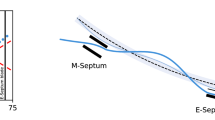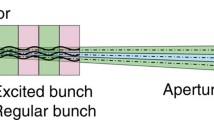Abstract
Slow resonant extraction from the synchrotron makes it possible to provide relatively stable beams for a long time. The principle of slow extraction is intentionally exciting the third-order resonance by controlling detuning and sextupole strength with the gradual release of particles from inside to outside a stable separatrix. The Budker Institute of Nuclear Physics (BINP) develops the ion synchrotron for a wide range of technological applications. This paper describes slow resonant extraction from an ion synchrotron with betatron oscillation excitation by a transverse RF field.










Similar content being viewed by others
REFERENCES
G. Balbinot, J. Bosser, E. Bressi, M. Caldara, M. Pullia, and G. Venchi, “RF-knockout extraction system for the CNAO synchrotron,” in Proceedings of the 1st International Particle Accelerator Conference (IPAC’10), Kyoto, Japan, 2010, THPEB007.
Author information
Authors and Affiliations
Corresponding author
Rights and permissions
About this article
Cite this article
Blinov, M.F., Koop, I.A., Vostrikov, V.A. et al. Slow Resonant Extraction from Ion Synchrotron for Technological Applications. Phys. Part. Nuclei Lett. 20, 708–713 (2023). https://doi.org/10.1134/S1547477123040118
Received:
Revised:
Accepted:
Published:
Issue Date:
DOI: https://doi.org/10.1134/S1547477123040118




